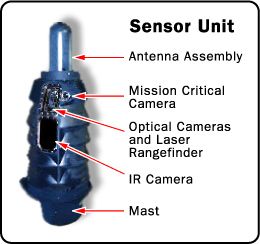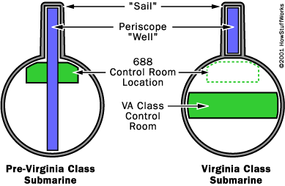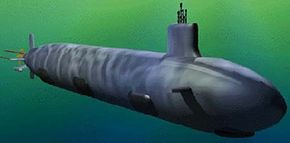Virginia's New Look
There are two problems with conventional optical periscopes. First, a periscope well runs the entire height of the ship to house the periscope, and its size restricts the arrangement of the sail and interior compartments. The second problem is that periscopes can accommodate only one person at a time. The Navy has developed a new AN/BVS-1 photonics mast to solve these two problems. The Virginia-class attack submarine, scheduled for debut in 2004, will be the first submarine equipped with photonics masts.
The photonics mast provides the imaging, navigation, electronic warfare and communications functions of a conventional optical periscope, according to U.S. Navy documents. Each Virginia-class submarine will have two photonics masts, which do not penetrate (retract into) the ship's hull. The mast will rise like a car antenna, in a telescopic motion.
Advertisement
Electronic imaging equipment will replace the prisms and lenses of the old optical periscopes. The heart of the system is the sensor unit that will protrude through the water. This multiple electro-optical sensor is located in a rotating head. The masts are equipped with three cameras, including a color camera, a high-resolution black-and-white camera and an infrared camera, to provide imaging for the submarine. There is also a mission critical control camera in a separate, pressure-proof and shock-hardened housing, and an eyesafe laser range finder that provides accurate target ranges and aids in navigation.

The periscope well that houses these masts will be contained only in the ship's sail. The smaller size of the periscope well allows for more freedom in determining the location of the ship's control room. With conventional periscopes, the control room had to be placed in the cramped upper deck. In the new Virginia-class submarine, the control room will be located on the wider second deck and will have a more open layout.

Images from the photonics masts are sent via fiber optics to two workstations and a commander's control console. The two photonics masts are controlled via joystick from any of these stations. Each station contains two flat-panel displays, a standard keyboard and a trackball interface. Images are recorded on both video cassette and CD-ROM.
The photonics mast is the latest tool to be added to the United States' electronic-warfare arsenal. This new technology will make the Virginia-class submarines the most advanced and automated submarines in the naval fleet.
Related HowStuffWorks Links
Other Great Links
- Virginia Class New Attack Submarine
- The Virginia Class: America's Next Submarine
- NOVA Online: See Inside a Submarine
- Submarines Today
- Popular Science: Shadow in the Shallows
- Submarine Warfare
